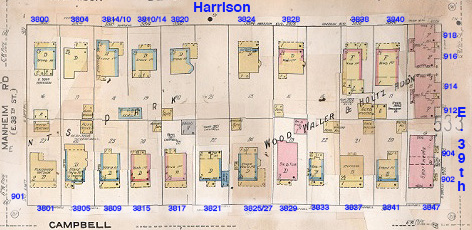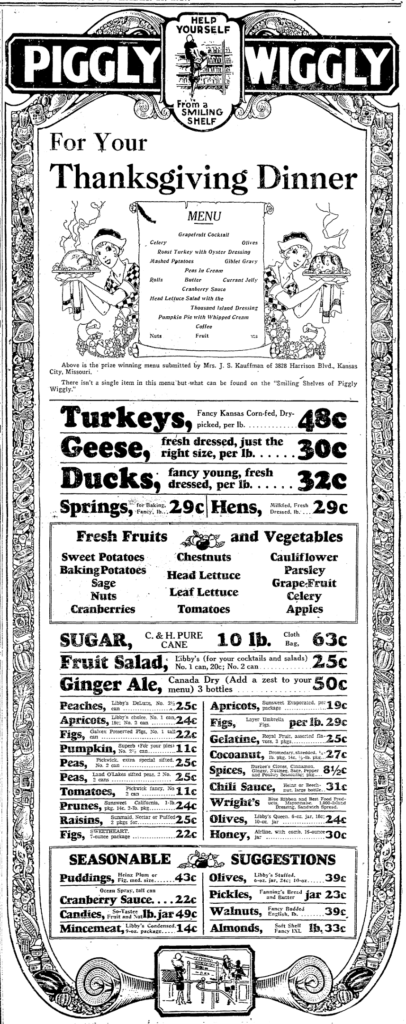
As Thanksgiving approached in 1927, it’s a pretty good bet that Effie Kauffman of Central Hyde Park was working on her holiday planning. Mrs. Kauffman’s prize-winning Thanksgiving menu was shared in the Nov. 22 Kansas City Star that year. It included a grapefruit cocktail, turkey with oyster dressing, peas in cream, leaf lettuce with Thousand Island dressing, and, of course, pumpkin pie for dessert. That fact is among the available history of the block from Harrison to Campbell, Manheim to E. 39th, now considered part of the Central Hyde Park neighborhood.
The area grew quickly between 1900 and 1920, filling in with extended families that included preachers, teachers, and car dealers. The homes were large and “modern” by early 1900 standards. The home at 3809 Campbell, for sale in 1909, had eight rooms, was made of quartered oak, and had an exterior of Warrensburg cut stone.
As part of our Uncovering History Project, the Midtown KC Post is examining each block in Midtown. A set of 1940 tax assessment photos is available for many blocks.
Unfortunately, the Kansas City Public Library does not have the 1940s photos from the block from Harrison to Campbell, Manheim to E. 39th.
The Neels of 3820 Harrison were among the prominent families on the block in those early years. The Rev. Samuel Neel was pastor of the Central Presbyterian Church from 1888 to 1912. His father was an elder in a Fayette County, Tennessee Presbyterian Church and owned a large plantation there. Samuel joined the Confederate army in the Civil War, fighting in several battles before being wounded and captured. He was released near the end of the war. He later studied in Scotland and Germany before becoming a minister in Mississippi and Kentucky.
Neel came to Kansas City in 1888 to preach at the Central Presbyterian Church at Eighth and Central. He also established a mission near Fifth and Lydia. Records show his son, Ellison Neel, living next door at 3824 Harrison until 1922. Rev. Neel and his wife both died in 1921.
Another Presbyterian minister, retired Dr. I.F. Swallow, lived on the block at 3801 Campbell in the 1920s.
Other Residents of the Block
Several teachers made their homes on the block. Louis and Frank Tuton, both teachers of mathematics, boarded with the Evan Hosier family at 3838 Harrison. Hosier, a retail jeweler, lived there with his wife Edith, son Abram, and mulatto servant Zelia O’Rear in 1910. Next door at 3840 Harrison, teacher Ethel Chapman lived with her mother, a widow, a sister, and a brother in 1910. And the Kirtley family, at 3828, also included three teachers that year.
Several families listed in that census in 1910 had live-in servants, often black or recent immigrants. The Neel family had a white servant named Bessie Turner. Edwin Moss, a 19-year-old mulatto servant, worked for the Kirtleys and the David B. Fant family at 3815 Cambell, employed mulatto servant Georgia Branham.
Push for Apartment Zoning
Frank Witwer, president of the Associated Motor Car Dealers of Kansas City, lived at 3804 Harrison in 1929. He was one of the pioneer car dealers in Kansas City and the nephew of Peter Studebaker and J.M. Studebaker, founders of the motor company. Witwer had started in the transportation industry when horses were a major mode of transportation and ended his career in 1932 as president of the Southwest Motor Company, Pierce-Arrow Distributors at Twenty-sixth and Grand Avenue along Kansas City’s ‘motorcar row.’”
In 1938, Witwer spoke on behalf of other property owners on Harrison: they hoped the city would rezone the 3800 block of Harrison to allow use as apartments. Many Midtown homes were converted to apartments during this period of housing shortage. In a petition filed with the city, 20 of the 24 owners said both sides of Harrison were occupied by 2½- and 2-story residences that owners wanted to be allowed to convert into 4-apartment buildings.
Historic photos courtesy Kansas City Public Library/Missouri Valley Special Collections.


The Piggly Wiggly Grocery named Effie Kauffman’s Thanksgiving menu the best of 1927 and shared it in this ad that highlighted Thanksgiving groceries that year.